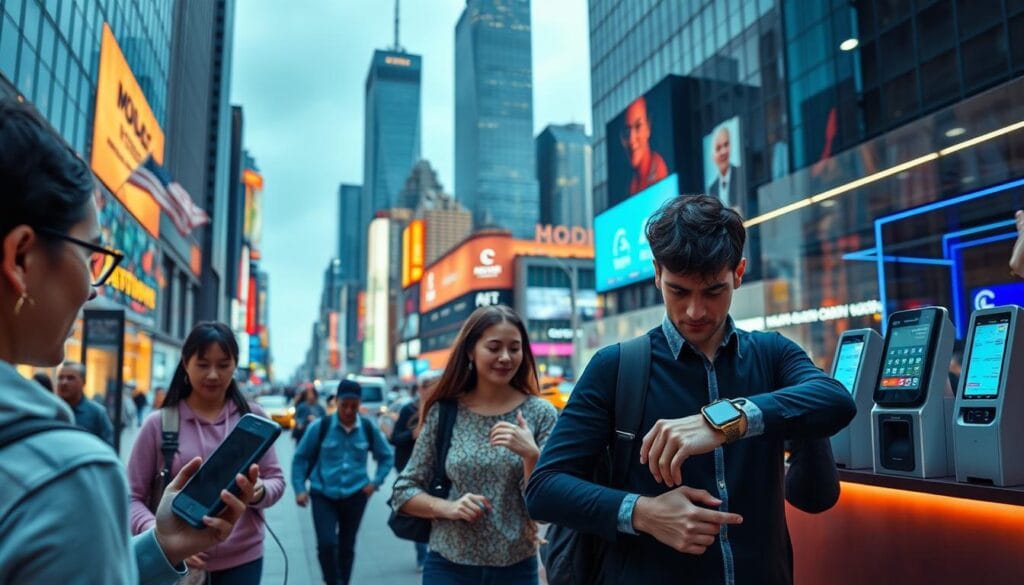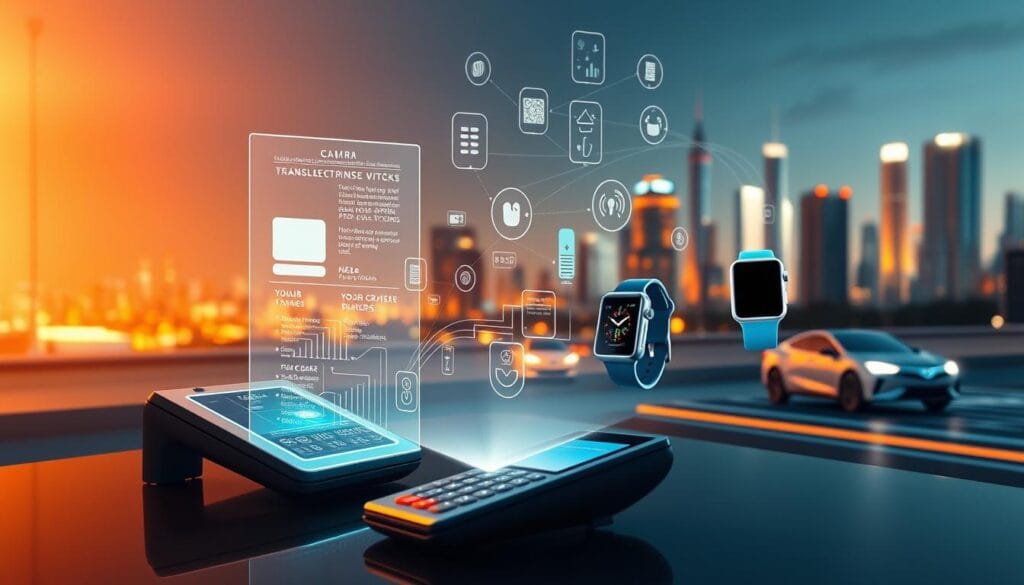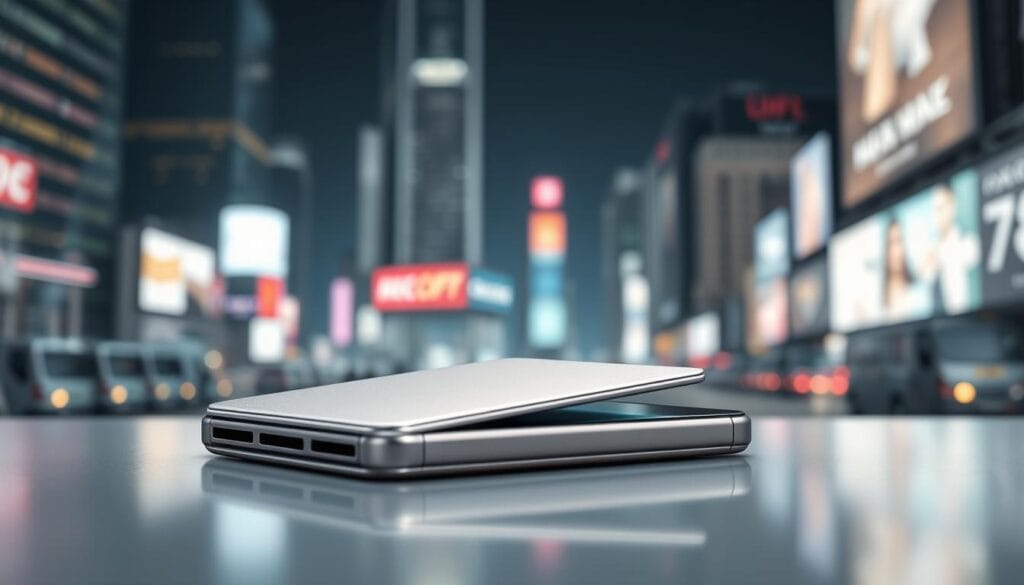By 2025, nearly 90% of U.S. consumers are projected to use contactless methods for their transactions. This rapid adoption is driven by convenience, speed, and enhanced security features. With a 19.1% CAGR growth expected through 2030, the U.S. is leading the charge in this transformative shift.
Digital wallets, such as Apple Pay, are set to dominate, accounting for 50% of e-commerce value by 2025. In 2022 alone, Apple Pay processed $199 billion in transactions, showcasing the growing reliance on mobile-based solutions. This trend is further amplified by advancements in biometric authentication and AI-driven security protocols, ensuring safer and more seamless experiences.
Globally, contactless transactions are expected to reach a staggering $10 trillion by 2027. This growth is fueled by the integration of these systems with smart cities and IoT ecosystems, creating a connected and efficient future. For more insights into the rise of biometric solutions, explore the rise of biometric payments.
Key Takeaways
- 90% of U.S. consumers will use contactless methods by 2025.
- Digital wallets will account for 50% of e-commerce value by 2025.
- Global contactless transactions are projected to hit $10 trillion by 2027.
- Biometric authentication and AI are enhancing security and convenience.
- Integration with smart cities and IoT is driving future growth.
Introduction to Contactless Payment Trends

The shift toward proximity-based transactions is reshaping how consumers interact with technology. These methods, which include RFID, NFC, and QR codes, require users to be within 4 centimeters of a terminal to complete a transaction. This close-range interaction ensures both speed and security, making it a preferred choice for many.
What Are Contactless Payments?
Proximity-based systems rely on advanced technologies like NFC and RFID to facilitate seamless exchanges. NFC, or Near Field Communication, is faster and more secure than traditional methods, while RFID uses radio waves for data transfer. QR codes, though slower, are widely used due to their accessibility and ease of implementation.
In the U.S., 51% of consumers actively use or would consider using these methods. Grocery stores, in particular, have seen an 85% adoption rate, highlighting their widespread appeal.
Why Are Contactless Payments Gaining Popularity?
Hygiene concerns have driven adoption, especially in restaurants, where 36% of transactions are now proximity-based. Additionally, tokenization technology has reduced fraud by 76% compared to traditional magstripe cards, enhancing trust in these systems.
Mobile wallets like Apple Pay and Google Pay are also contributing to this growth. With 130 million users in the U.S., Apple Pay leads the market, while Google Pay follows with 25 million users. These platforms offer unmatched convenience and security, making them a top choice for tech-savvy consumers.
The Evolution of Contactless Payments

The journey of contactless systems began decades ago, evolving into a global phenomenon. What started as a niche innovation has now become a cornerstone of modern financial interactions. Over the years, advancements in technology have driven this transformation, making it a preferred choice for consumers and businesses alike.
From Early Adoption to Mainstream Use
In 1995, Seoul introduced the Upass bus card, marking the first large-scale implementation of contactless systems. This early adoption laid the groundwork for future developments. By 2005, Samsung and Philips unveiled an NFC smartphone prototype in France, showcasing the potential of this technology.
Fast forward to 2019, Australia achieved an impressive 80% usage rate for contactless credit cards, highlighting its widespread acceptance. This growth was further accelerated by the pandemic, which saw the UK issue over 142 million contactless cards by 2020.
Key Milestones in Contactless Payment History
Several pivotal moments have shaped the market. In 2005, EMVCo standardization enabled global interoperability, making these systems more accessible. Visa’s rollout of 300 million+ contactless cards further solidified its position as a leader in this space.
Despite challenges, such as the 9% penetration rate in U.S. transit systems, adoption continues to grow. The launch of Apple Pay in 2014 and Google Pay in 2015 marked a new era, integrating these methods into everyday life. For more insights, explore contactless payments and their future.
Current State of Contactless Payments in the U.S.

The U.S. is witnessing a significant shift in how transactions are conducted. Proximity-based systems are now a staple in retail and e-commerce, driven by consumer demand for speed and security. In April 2023, 55.8 million Americans used Apple Pay for in-store purchases, showcasing the growing reliance on mobile-based solutions.
Adoption Rates and Consumer Behavior
Demographic trends reveal that 60% of consumers under 40 prefer proximity-based systems, compared to just 38% of those over 40. This generational divide highlights the role of familiarity with mobile devices in driving adoption. Grocery stores and restaurants are leading the charge, with over 85% of transactions now using these methods.
Leading Contactless Payment Platforms
Apple Pay dominates the market, with $199 billion in point-of-sale spending in 2022, far outpacing Google Pay’s $65.2 billion. Apple’s closed ecosystem strategy has been a key factor, generating $1.9 billion in issuer fees the same year. Meanwhile, Android’s open NFC policy has enabled innovations like instant card replacement in apps from Capital One and Citibank.
Looking ahead, digital wallet transactions are projected to grow by 150% by 2028, driven by advancements in mobile devices and consumer trust in these platforms. As iOS continues to hold a 55% market share in the U.S., Apple Pay is poised to maintain its leadership in the space.
Benefits of Contactless Payments

The advantages of proximity-based systems are transforming how people handle everyday transactions. These methods offer a blend of speed, safety, and efficiency, making them a preferred choice for consumers and businesses alike. With 76% of users citing speed as their primary reason for adoption, it’s clear that these systems are reshaping financial interactions.
Convenience and Speed
One of the standout features of these systems is their ability to complete transactions in just 2.5 seconds, compared to 8.7 seconds for traditional chip-and-PIN methods. This efficiency is particularly valuable in high-traffic environments like grocery stores and transit systems. Consumers appreciate the seamless experience, which reduces wait times and enhances overall satisfaction.
Merchants also benefit from reduced cash handling costs, saving up to 23% in operational expenses. This dual advantage for both parties is driving widespread adoption across industries. For more insights into how technology is streamlining financial processes, explore fast and cheap cross-border payments using.
Enhanced Security Features
Security is a top priority in modern financial systems. Tokenization, a key feature, reduces the risk of data breaches by 83%, ensuring that sensitive information remains protected. Additionally, dynamic CVV codes replace static magnetic stripe vulnerabilities, offering an extra layer of defense against fraud.
Biometric authentication, such as Face ID and Touch ID, further enhances safety by linking transactions to unique user identifiers. These advancements have led to a 97% satisfaction rate among users in contactless-first retailers. With the integration of EMV 3-D Secure protocols, e-commerce platforms are also becoming more secure, fostering trust in digital transactions.
Challenges Facing Contactless Payments

Despite their popularity, these systems encounter significant obstacles in their adoption. While they offer speed and convenience, concerns around security and infrastructure remain key barriers. Addressing these issues is crucial for their continued growth in the market.
Privacy and Security Concerns
One of the biggest challenges is the risk of NFC skimming, which worries 43% of consumers. Vulnerabilities in Android devices, such as those reported by Interpol in 2016, have further heightened these concerns. The PCI SSC has issued guidelines to address these issues, but security remains a top priority for users and businesses alike.
Infrastructure and Technological Barriers
Upgrading to NFC-capable terminals can cost small businesses an average of $1,200, a significant investment for many. Additionally, 28% of U.S. merchants still lack the necessary POS systems, creating adoption gaps. Rural areas face even greater challenges, with adoption rates 12% lower than in urban regions.
Legacy system integration and dual-interface card migration costs also pose hurdles for issuers. These technological and infrastructure barriers must be addressed to ensure widespread adoption across the market.
How Tech Leaders Are Addressing Challenges

Tech leaders are stepping up to tackle the challenges surrounding modern financial systems. From enhancing security to driving innovations, companies are working to create safer and more efficient solutions. These efforts are critical to maintaining consumer trust and ensuring widespread adoption.
Prioritizing Privacy and Security
Privacy and security remain top concerns for both consumers and businesses. Visa’s 0.15% transaction fee structure for Apple Pay reflects the industry’s focus on secure transactions. EMVCo’s qVSDC protocol, which enables offline transactions, is another example of how leaders are addressing these issues.
Apple’s Core NFC lockdown contrasts with Android’s open API, offering tighter control over data access. This approach ensures that sensitive information remains protected, even in high-risk environments. Bank of America’s encrypted wearables initiative further highlights the commitment to safeguarding user data.
Innovations in Payment Technology
Advancements in technology are reshaping the landscape of financial services. Mastercard’s AI-powered fraud detection networks are setting new standards for security, reducing risks by 83%. These systems analyze transaction patterns in real-time, flagging suspicious activities before they escalate.
Omniwire’s secure financial service frameworks are also making waves, providing robust solutions for businesses. Clearly Payments’ NFC terminal deployment stats show a 35% increase in adoption, driven by the demand for seamless credit transactions. These innovations are paving the way for a more connected and efficient future.
The Role of Mobile Wallets in Contactless Payments

Mobile wallets have become a cornerstone of modern financial interactions, offering unparalleled convenience and security. These platforms, such as Apple Pay, Google Pay, and Samsung Pay, are transforming how consumers handle everyday transactions. With a 74% iPhone activation rate for Apple Pay, these systems are increasingly integrated into daily life.
Apple Pay, Google Pay, and Samsung Pay
Apple Pay leads the market, with its closed ecosystem ensuring tight security and seamless integration with iOS devices. In 2022, Samsung Pay processed $19.6 billion in U.S. transactions, showcasing its growing adoption. Meanwhile, Google Pay leverages Android’s open NFC policy, enabling innovations like instant card replacement.
These platforms are not just limited to smartphones. They are increasingly integrated into wearables like Garmin and Fitbit, as well as automotive systems such as BMW’s Digital Key Plus. This versatility enhances user convenience and expands their utility across various devices.
Integration with Smart Devices
The integration of mobile wallets with smart devices is driving their adoption. For instance, U.S. Bank’s tokenization-as-a-service platform ensures secure transactions across multiple devices. Starbucks’ closed-loop system is another success story, combining payments with loyalty rewards to enhance customer engagement.
Looking ahead, NFC transactions are projected to grow by 150% by 2028, fueled by advancements in smartphone technology and consumer trust. For more insights into how mobile wallets are shaping the future, explore this detailed analysis.
Wearable Devices and Contactless Payments

Wearable devices are revolutionizing how people interact with financial systems. From smartwatches to fitness trackers, these devices are becoming essential tools for seamless transactions. With a 9% current U.S. wearable payment share, the adoption of these technologies is steadily growing.
Smartwatches and Fitness Trackers
Smartwatches like Garmin Pay are leading the charge, offering use cases for outdoor activities where traditional methods fall short. These wearables provide a convenient way to make transactions without carrying physical cards or smartphones.
Fitness trackers are also integrating payment capabilities, catering to health-conscious consumers. Barclays’ experiments with NFC wristbands and stickers highlight the potential for these devices to simplify everyday transactions. This trend is expected to grow at a 22% CAGR from 2023 to 2030.
Future Potential of Wearable Payment Technology
The future of wearable payments extends beyond smartwatches. Biometric rings, like those from McLear and NFC Ring, are in development, offering a new level of security and convenience. These prototypes use unique identifiers to ensure safe transactions.
Innovations like skin-mountable NFC patches and medical device integrations, such as insulin pumps, are also on the horizon. Luxury watch brands like Tag Heuer and Tissot are adopting these technologies, further expanding their appeal. These advancements highlight the limitless potential of wearable technology in reshaping financial interactions.
Global Trends in Contactless Payments

Global adoption of proximity-based systems varies significantly across regions. Countries like the UK, Australia, and Singapore lead with adoption rates of 93.4%, 95%, and 97%, respectively. These nations have embraced these methods due to their convenience and security. In contrast, Germany and Japan show lower adoption rates, at 35% and 20-30%, reflecting cultural and regulatory differences.
Adoption Rates Across Different Countries
China stands out with its dominance in QR code usage, accounting for 89% of mobile transactions. This contrasts with the reliance on physical cards in Western markets. For more insights, explore a study on proximity-based systems by.
India’s UPI system processes over 10 billion monthly transactions, showcasing its success in digital financial inclusion. Similarly, Brazil’s Pix system has seen rapid adoption, transforming the market for instant payments.
Cultural and Regulatory Influences
The EU’s PSD2 regulation has significantly impacted open banking, fostering innovation in the market. This has encouraged the integration of proximity-based systems into everyday financial interactions. Learn how open banking is shaping financial systems.
In the MENA region, proximity-based systems grew by 41% in 2023, driven by increasing digitalization. Central Bank Digital Currencies (CBDCs) are also gaining traction, further reducing reliance on cash and enhancing transaction efficiency.
The Impact of COVID-19 on Contactless Payments
The COVID-19 pandemic reshaped financial interactions globally. Health concerns and CDC warnings about surface transmission drove a 58% surge in global usage of proximity-based systems from 2020 to 2022. This shift was not just a temporary response but a lasting change in how consumers approach transactions.
Accelerated Adoption During the Pandemic
During the pandemic, adoption of these systems skyrocketed. Governments and businesses responded by increasing transaction limits, such as the UK raising its cap to £100 and the EU to $50. Small businesses were incentivized to upgrade their POS systems, further driving growth in the market.
NFC terminal production also saw a significant spike, as businesses rushed to meet consumer demand for safer, faster options. This rapid shift highlighted the importance of adapting to new technologies in times of crisis.
Long-Term Effects on Consumer Behavior
The pandemic’s impact extended beyond immediate changes. Studies show that 63% of consumers maintained their proximity-based habits even after the crisis subsided. This shift aligns with the behavioral economics principle of habit formation, which suggests that new behaviors solidify after 66 days of consistent practice.
Cash usage declined significantly, with Australia reporting a drop to 19% in 2023. This trend underscores the lasting influence of the pandemic on financial systems. For more insights, explore global payment statistics.
Future Innovations in Contactless Payments
Emerging technologies are redefining how we interact with financial systems. From biometric authentication to blockchain, these advancements are setting the stage for a more secure and efficient future. With 78% of banks testing biometric payment cards by 2025, the focus is on enhancing both convenience and safety.
Biometric Authentication and Voice-Activated Systems
Biometric authentication is becoming a cornerstone of modern financial security. Palm vein recognition, like Amazon One, is already in pilot stages, offering a unique way to verify identities. This technology ensures that only authorized users can access their accounts, reducing fraud risks.
Voice-activated systems are also gaining traction. Juniper Research forecasts 320 million users by 2027, driven by the convenience of hands-free transactions. For more insights, explore how voice-activated assistants are transforming financial.
AI and Blockchain in Enhancing Security
Artificial intelligence is playing a pivotal role in safeguarding financial data. AI-powered behavioral biometrics, such as TypingDNA, analyze user patterns to detect anomalies in real-time. This proactive approach minimizes risks and ensures smoother transactions.
Blockchain is another game-changer, especially for cross-border payments. Visa’s B2B Connect leverages this technology to enable faster and more secure settlements. Quantum-resistant encryption protocols are also in development, ensuring that financial systems remain robust against future threats.
These innovations highlight the limitless potential of advanced devices and services in reshaping how we handle money. As these trends evolve, they promise a future where financial interactions are safer, faster, and more efficient.
Conclusion
The future of financial transactions is being shaped by rapid technological advancements and evolving consumer preferences. By 2025, the U.S. market is expected to lead in adoption, yet challenges remain in maintaining this leadership. Merchants must consider upgrading terminals to stay competitive, while financial institutions should prioritize innovation to meet consumer demands.
Security remains a critical factor in driving growth. As more consumers embrace contactless payments, ensuring robust protection against fraud is essential. This shift also raises ethical questions about the move toward a cashless society, emphasizing the need for inclusive and secure solutions.
For businesses and individuals alike, staying informed about these developments is crucial. Explore how AI-powered apps can help manage finances in this evolving landscape. The journey toward seamless and secure transactions is just beginning, and the opportunities are vast.

